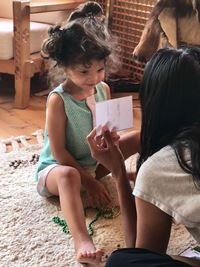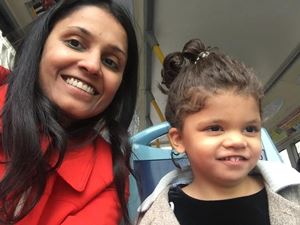 |
| Alya |
When Taruna Reddy’s daughter Alya began having seizures as an infant, she and her husband Nicholas Vassalli understood something serious could be afoot.
“We knew there was a big problem,” she said. “We weren’t sitting there thinking that this was going to go away.”
It wasn’t until their child was three, however, that they had a diagnosis in hand. Following doctor’s orders, they tried testing different parts of Alya’s genome in search for a cause, but each time they came away without a culprit. It wasn’t until they participated in a study at Columbia University’s Columbia Genome Center that full exome testing was done and the parents knew the cause of their daughter’s symptoms—a mutation on the PACS1 gene.
The expression of the PACS1 gene is significant both during embryonic development and after birth, in the brain and a variety of organs. People with this gene mutation suffer from developmental delays, intellectual disability, and speech and language delays.
“The diagnosis was actually really helpful. We knew what she had and we knew what we could do” Reddy said. “There was an active group and we shared information. That’s when we started to talk about forming a foundation and making a difference.”
With that knowledge in hand, Reddy, her family, and other patients and families formally organized the PACS1 Syndrome Research Foundation, a nonprofit organization dedicated to advancing research in search of treatments for the disease.
As part of that mission, the group contacted Sameer Kalghatgi, PhD, Coriell’s director of laboratory operations at the time, for assistance. They knew of scientists interested in PACS1, but they lacked access to the biological materials – specifically induced pluripotent stem cells (or iPSCs) – they needed for their work.
“With commercial firms, you can get lost in the process. You don’t have the contact we had with Dr. Kalghatgi,” Reddy said. “We were always in the loop and the production moved forward very quickly.”
To create these iPSCs, Coriell’s Stem Cell Lab reprogrammed patient-derived mature skin cells by introducing four genes encoding key transcription factors – alternatively called “reprogramming factors” – discovered by Dr. Yamanaka, who won the 2012 Nobel Prize in Physiology, in a way that converted them back to a pluripotent stem cell like state. These iPSCs can then be differentiated into just about any cell type in the body – such as neurons, heart, liver and pancreatic cells. Since iPSCs are derived from a patient or donor’s own cells, they not only overcome the ethical concerns of using embryonic stem cells, but also are made in an autologous or donor-matched manner.
Reddy’s father-in-law is Jean-Dominique Vassalli, a medical doctor with a developmental biology background who is also helping to lead the foundation’s scientific effort.
“These cells are helpful in screening for therapeutics. You can run a drug screen using iPSCs to see if that changes the phenotype and makes it function normally again,” Dr. Vasselli said. “Using patient cells is more to the point than generating new cells from an established cell line. You’re closer to the real material.”
 |
| Taruna and Alya |
One such scientist is Gary Thomas, PhD, at the University of Pittsburgh. Reddy said Dr. Thomas discovered the PACS1 gene and has been with the PACS1 Syndrome Research Foundation since the beginning. He’s now one of a team of scientific advisors that Reddy said has become a source of motivation.
“If they spend their time on this subject, they must see something there. That is an encouragement,” Reddy said. “For parents, this is hard, but these scientists have given them hope.”
Deborah Requesens, PhD, is a program director at Coriell and oversees the NIGMS Human Genetic Cell Repository, a collection of biosamples housed at Coriell and available to scientists around the world. Her role brings her in contact with patients and rare disease advocacy groups, as well as scientists in need of samples.
“A couple of things over the last 10 years or so have really allowed patients and their families to not only get to know the researchers working on diseases, but actually become involved and steer the research themselves,” Dr. Requesens said. “Technological advances in this field have of course been key. The technology costs continue to drop and make sequencing more available.”
The other factor she credits with the trend of patients driving research is the explosion of social media. Platforms such as Facebook and Twitter have allowed people with some of the rarest diseases in the world to find each other and organize with ease. These groups are more empowered than ever to network, tell their stories and become a critical part of the scientific community.
“I don’t have a background in genetics,” Reddy said. “But interacting with these scientists who care so much about the children and are hopeful for the effort, it’s really been quite an incredible experience.”